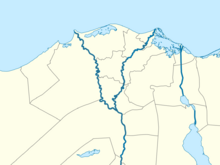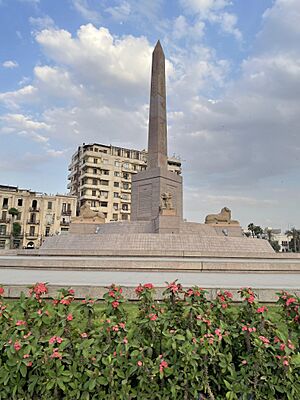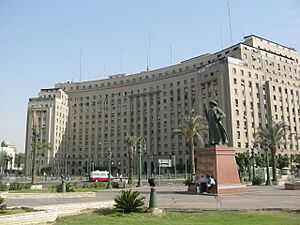Tahrir Square facts for kids
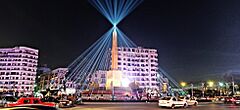
Tahrir Square in December 2020
|
|
| Former name(s) | Ismailia Square |
|---|---|
| Location | Downtown Cairo, Cairo, Egypt |
| Coordinates | 30°2′40″N 31°14′9″E / 30.04444°N 31.23583°E |
| Other | |
| Designer | Khedive Ismail |
Tahrir Square (meaning "Liberation Square" in Arabic) is a famous public square in downtown Cairo, Egypt. It is also sometimes called Martyr Square. This square has been a very important place for people to gather and express their opinions. Many big protests have happened here. For example, the 2011 Egyptian revolution took place in Tahrir Square. This led to the resignation of President Hosni Mubarak.
Contents
History of Tahrir Square
How the Square Got Its Name
The square was first named "Ismailia Square." It was named after Khedive Ismail, who ruled Egypt in the 1800s. He wanted to build a new downtown area for Cairo that looked like Paris.
After the Egyptian Revolution of 1919, people started calling the square "Tahrir," which means "Liberation." In 1933, King Fuad I officially renamed it "Khedive Ismail Square." A garden and a roundabout were added to the center. Later, King Farouk put a pedestal there for a statue of Khedive Ismail, but the statue was never put up.
The square was officially renamed "Tahrir Square" in 1953. This happened after the Egyptian Revolution of 1952. This revolution changed Egypt from a constitutional monarchy (a country with a king or queen) into a republic (a country led by elected officials).
In 1981, the square was renamed "Anwar El Sadat Square." This was done to honor President Anwar Sadat after he was assassinated. However, most Egyptians continued to call it Tahrir Square. The pedestal for the statue was removed in 1987. This happened when the Sadat metro station was built under the square.
Tahrir Square and Protests
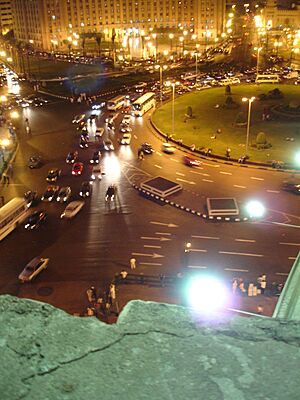
Tahrir Square has been a key place for many important protests. These include the Egyptian Revolution of 2011. It was also central to the June 2013 Egyptian protests that led to President Morsi being removed from power.
In 2013, a memorial was put up to honor people who died in the 2011 and 2013 protests. But protesters destroyed it soon after. They felt the government was trying to control the memory of these events. In 2015, a large flagpole with the Egyptian flag was placed in the center. Authorities hoped this would be a more neutral symbol.
In 2020, a new monument was added to the square. It features an ancient obelisk from the time of Ramesses II. This obelisk was found in 2019 at Tanis. Four ram-headed sphinx statues from Karnak were also moved there. Some experts worry that the soft stone of the sphinxes could be damaged by pollution. Others believe this new monument is a way for the government to control the public space. They think it might be an attempt to make people forget the 2011 Egyptian revolution.
What You Can Find in Tahrir Square
At the very center of Tahrir Square is a large, busy traffic circle. The ancient obelisk of Ramses II was placed here in 2020. On the northeast side, there is a plaza with a statue of Umar Makram. He was a national hero known for fighting against Napoleon's invasion of Egypt. Nearby is the Umar Makram Mosque.
The square is also a major crossroads. It is the end point for Qasr al-Ayn Street and Talaat Harb Street. Qasr al-Nil Street crosses the square and leads directly to the Qasr al-Nil Bridge over the Nile River.
Many important buildings are located around Tahrir Square. These include the famous Egyptian Museum. You can also find the The Mogamma government building and the Headquarters of the Arab League. The original downtown campus of the American University in Cairo is also here. The building that used to be the National Democratic Party-NDP headquarters was burned during the revolution and torn down in 2015.
The Cairo Metro has a station called Sadat Station under Tahrir Square. This station is a main hub for the metro system. It connects to many parts of Greater Cairo. The underground walkways from the metro station are the safest way for people to cross the busy roads of the square.
Public Use and Demonstrations
Tahrir Square has always been a popular spot for large protests. These include the 1977 Egyptian Bread Riots and a protest against the War in Iraq in 2003.

The 2011 Revolution
Tahrir Square was the main gathering place for the 2011 Egyptian revolution. This revolution was against former president Hosni Mubarak. On January 25, over 50,000 protesters first gathered in the square. Over the next few days, more and more people came.
By January 31, news channels reported that hundreds of thousands of people were protesting. On February 1, some reports even said over a million people were in the square. However, some experts believe the actual number was closer to 300,000.
The square became a powerful symbol for the protests. On February 2, there was some violence between groups supporting and opposing Mubarak. But the protests continued. Because of news coverage, Tahrir Square became known around the world.
A Facebook page called "Tahrir Square" was created during the uprising. It helped share information when state-run media was not giving accurate reports.
The protests lasted for 18 days. On February 11, 2011, President Mubarak officially stepped down. He gave all his power to the Supreme Council of the Armed Forces. Tahrir Square erupted in celebration that night. People were shouting with joy and pride. The next day, many Egyptians came to clean up the square. They removed trash and graffiti, showing their commitment to rebuilding their country.
After the Revolution
After the 2011 revolution, Tahrir Square remained a symbol of change. Many important visitors came to see it. These included British Prime Minister David Cameron and U.S. Secretary of State Hillary Clinton. Even American actor Sean Penn visited the square.
Protests in 2013
On June 29, 2013, thousands of Egyptians returned to Tahrir Square. They were protesting against President Mohamed Morsi and demanding he resign. They used the same slogan as in 2011: "the people want the ouster of the regime."
By June 30, hundreds of thousands of protesters were in the square. On July 3, General Abdul Fatah al-Sisi announced that President Morsi had been removed from power. He also suspended the Egyptian Constitution of 2012. Some people called this a "coup d'état" (when a government is overthrown by force). Others, especially those who supported the protests, called it another "revolution."
Pharaoh's Golden Parade
On April 3, 2021, Tahrir Square hosted a special event. It was called the Pharaohs' Golden Parade. Twenty-two ancient mummies were moved from the Egyptian Museum to the National Museum of Egyptian Civilization. This parade was a grand and historic sight in the square.
See also
- Downtown Cairo
- The Square, a documentary film about the square and its role in Egyptian politics


